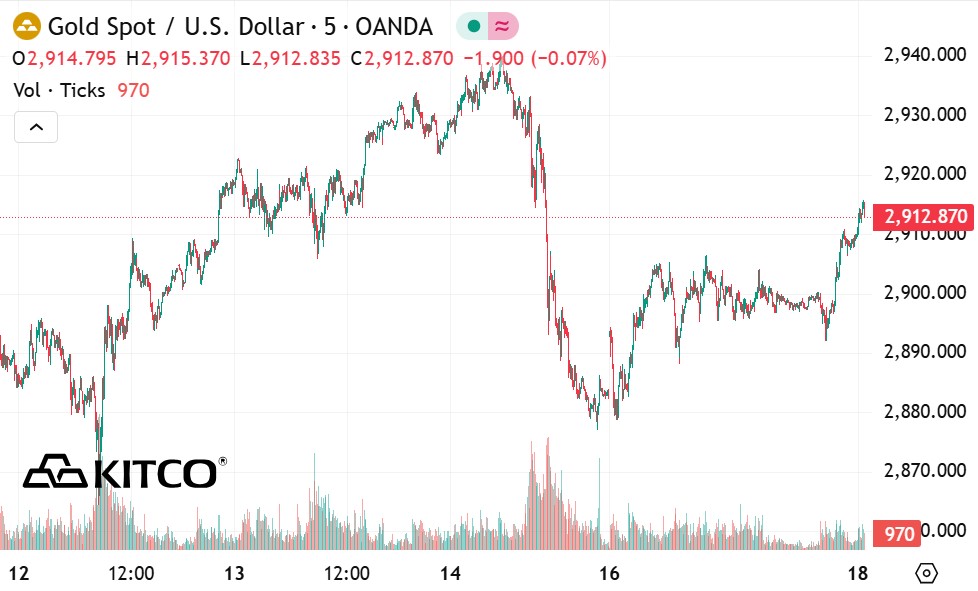Cash flow from China increases investment demand for gold
According to Kitco - a group of 10 major Chinese insurance companies has been approved to invest up to 1% of total assets (~27.4 billion USD) in gold bars.
According to current gold prices, this investment is equivalent to about 295 tons, accounting for 34% of the total demand for gold bars in 2024. Over the past year, investment demand for gold bars has increased by 10% over the same period, reaching 1,185 tons.
Analysts at Heraeus predict that if these insurance companies carry out the planned investment, gold investment demand in 2025 could increase by at least 25%. This could maintain gold's upward momentum. Especially since 2024, this precious metal has reached a new record high 39 times. Since the beginning of 2025, gold prices have peaked eight times.
The trading volume on the Shanghai Gold Exchange also showed strong interest from Chinese investors. Last week, the total trading volume reached 44,000 tons, accounting for more than 95% of the average weekly volume over the past four years. This shows the positive sentiment of investors even though gold prices are constantly reaching new peaks.

Uncertainty about tariffs to support gold prices
Despite the strengthening US economy, uncertainties related to trade tariffs may continue to support gold prices in the medium term. Heraeus noted that Federal Reserve Chairman Jerome Powell avoided the impact of tariffs in a hearing before Congress last week, raising uncertainty about the US economic outlook.
In February, the Relative Strength Index (RSI) of spot gold prices remained above 70 (oversold), after many sessions of price increases to record highs. This led to a slight correction in gold prices, from a peak of $2,941/ounce on Tuesday to $2,896/ounce on Friday.
However, gold prices have largely recovered after the weekend correction and are trying to re-establish support at $2,900/ounce earlier this week.
AI and technology can boost gold demand
In addition to traditional investment, Heraeus also commented that the field of artificial intelligence (AI) is gradually becoming a factor supporting gold prices. Chinese AI company DeepSeek released the open source AI model R1 in January, which reduces hardware requirements for large language models.
However, instead of reducing the demand for GPUs, more efficient AI models can promote the use of hardware, thereby increasing demand for gold in the production of chips and electronic devices.
In 2023, NVIDIA shipped 3.7 million data center GPUs, consuming 2 tons of gold - equivalent to nearly 1% of total global demand for e-gold. Experts expect demand for gold from the AI industry to continue to increase as the technology expands to the automotive and robot sectors.
It is worth mentioning that the demand for gold in the electronics industry in 2024 is still 15% lower than in 2010, so it is unlikely to surpass historical growth rates.
Silver benefits from the development of the 5G network
While gold benefits from safe-haven demand, silver prices continue to be supported by industrial demand. Heraeus points out that the development of the 5G network is maintaining demand for the metal.
Global smartphone sales increased by 7% year-on-year in 2024, reaching 1.22 billion units, of which the 5G phone ratio increased from 58% in 2023 to 64% in 2024. Although 5G phones are not a major source of silver consumption, 5G infrastructure such as transmission stations, tons and receivers rely heavily on silver to ensure electricity conduction.
It is forecasted that the total demand for silver in 5G-related fields could reach 15-17 million ounces by 2025, with 5G car and semiconductor connections accounting for 66% of the total. The 5G root station market, worth $28 billion in 2024, is expected to increase fivefold to $ 140 billion in 2029.
Silver prices are also witnessing strong fluctuations. After last week's fluctuations, spot silver prices are now recorded at 32.322 USD/ounce, up 0.54% on the day.
In general, gold prices continue to benefit from strong investment flows from China, safe-haven demand and the development of the technology industry. Meanwhile, silver is maintaining its position thanks to the expansion of 5G infrastructure and electrification of the power grid.
Despite the possibility of short-term corrections, the long-term outlook for both precious metals is still positive, especially in the context of the global economy still having many uncertain factors.











